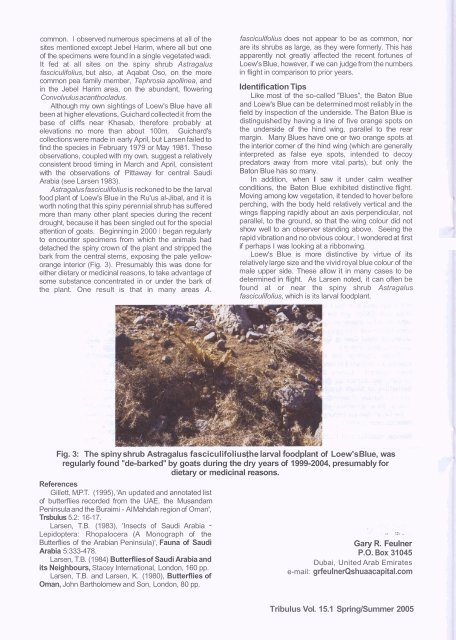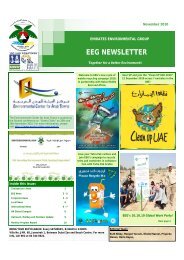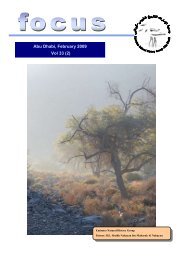Oman (Lepidoptera: Pieridae) - Al Ain Chapter, Emirates Natural ...
Oman (Lepidoptera: Pieridae) - Al Ain Chapter, Emirates Natural ...
Oman (Lepidoptera: Pieridae) - Al Ain Chapter, Emirates Natural ...
You also want an ePaper? Increase the reach of your titles
YUMPU automatically turns print PDFs into web optimized ePapers that Google loves.
common. I observed numerous specimens at all of the<br />
sites mentioned except Jebel Harim, where all but one<br />
of the specimens were found in a single vegetated wadi.<br />
It fed at all sites on the spiny shrub Astragalus<br />
fasciculifolius, but also, at Aqabat Oso, on the more<br />
common pea family member, Tephrosia apollinea, and<br />
in the Jebel Harim area, on the abundant, flowering<br />
Convolvulus acanthocladus.<br />
<strong>Al</strong>though my own sightings of Loew's Blue have all<br />
been at higher elevations, Guichard collected it from the<br />
base of cliffs near Khasab, therefore probably at<br />
elevations no more than about 100m. Guichard's<br />
collections were made in early April, but Larsen failed to<br />
find the species in February 1979 or May 1981. These<br />
observations, coupled with my own, suggest a relatively<br />
consistent brood timing in March and April, consistent<br />
with the observations of Pittaway for central Saudi<br />
Arabia (see Larsen 1983).<br />
Astragalus fasciculifolius is reckoned to be the larval<br />
food plant of Loew's Blue in the Ru'us al-Jibal, and it is<br />
worth noting that this spiny perennial shrub has suffered<br />
more than many other plant species during the recent<br />
drought, because it has been singled out for the special<br />
attention of goats. Beginning in 2000 I began regularly<br />
to encounter specimens from which the animals had<br />
detached the spiny crown of the plant and stripped the<br />
bark from the central stems, exposing the pale yellow-<br />
orange interior (Fig. 3). Presumably this was done for<br />
either dietary or medicinal reasons, to take advantage of<br />
some substance concentrated in or under the bark of<br />
the plant. One result is that in many areas A.<br />
fasciculifolius does not appear to be as common, nor<br />
are its shrubs as large, as they were formerly. This has<br />
apparently not greatly affected the recent fortunes of<br />
Loew's Blue, however, if we can judge from the numbers<br />
in flight in comparison to prior years.<br />
Identification Tips<br />
Like most of the so-called "Blues", the Baton Blue<br />
and Loew's Blue can be determined most reliably in the<br />
field by inspection of the underside. The Baton Blue is<br />
distinguished by having a line of five orange spots on<br />
the underside of the hind wing, parallel to the rear<br />
margin. Many Blues have one or two orange spots at<br />
the interior corner of the hind wing (which are generally<br />
interpreted as false eye spots, intended to decoy<br />
predators away from more vital parts), but only the<br />
Baton Blue has so many.<br />
In addition, when I saw it under calm weather<br />
conditions, the Baton Blue exhibited distinctive flight.<br />
Moving among low vegetation, it tended to hover before<br />
perching, with the body held relatively vertical and the<br />
wings flapping rapidly about an axis perpendicular, not<br />
parallel, to the ground, so that the wing colour did not<br />
show well to an observer standing above. Seeing the<br />
rapid vibration and no obvious colour, I wondered at first<br />
if perhaps I was looking at a ribbonwing.<br />
Loew's Blue is more distinctive by virtue of its<br />
relatively large size and the vivid royal blue colour of the<br />
male upper side. These allow it in many cases to be<br />
determined in flight. As Larsen noted, it can often be<br />
found at or near the spiny shrub Astragalus<br />
fasciculifolius, which is its larval foodplant.<br />
Fig. 3: The spiny shrub Astragalus fasciculifolius, the larval foodplant of Loew's Blue, was<br />
regularly found "de-barked" by goats during the dry years of 1999-2004, presumably for<br />
dietary or medicinal reasons.<br />
References<br />
Gillett, M.P.T. (1995), 'An updated and annotated list<br />
of butterflies recorded from the UAE, the Musandam<br />
Peninsula and the Buraimi - <strong>Al</strong> Mahdah region of <strong>Oman</strong>',<br />
Trsbulus 5.2: 16-17.<br />
Larsen, T.B. (1983), 'Insects of Saudi Arabia -<br />
<strong>Lepidoptera</strong>: Rhopalocera (A Monograph of the<br />
Butterflies of the Arabian Peninsula)', Fauna of Saudi<br />
Arabia 5:333-478.<br />
Larsen, T.B. (1 984) Butterflies of Saudi Arabia and<br />
its Neighbours, Stacey International, London, 160 pp.<br />
Larsen, T.B. and Larsen, K. (1980), Butterflies of<br />
<strong>Oman</strong>, John Bartholomew and Son, London, 80 pp.<br />
Gary R. Feulner<br />
P.O. Box 31045<br />
Dubai, United Arab <strong>Emirates</strong><br />
e-mail: grfeulnerQshuaacapital.com<br />
Tribulus Vol. 15.1 Spring/Summer 2005<br />
.




